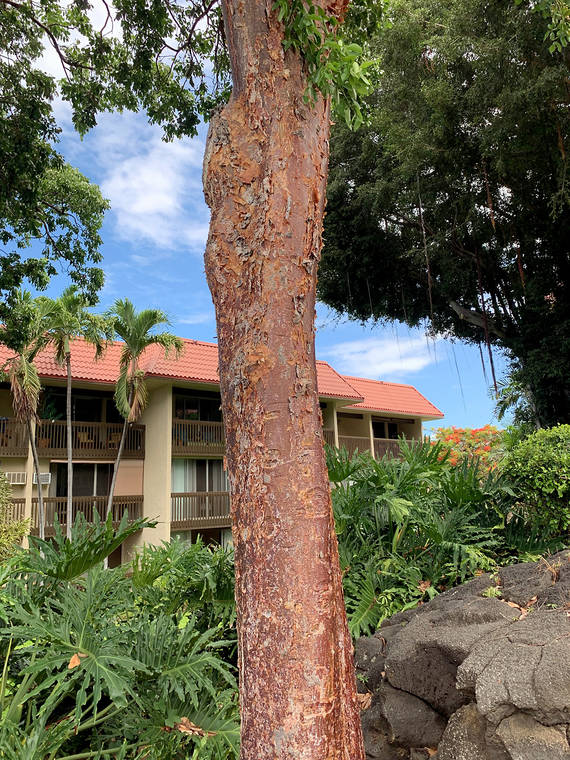The Gumbo Limbo, Bursera simaruba, also called the Naked Indian Tree in the Caribbean, is hard to miss because of its reddish shiny bark. It is also referred to as the Living Fencepost Tree since a cutting of almost any size will grow easily. It is often used as fence posts by farmers and ranchers in tropical America because it continues to grow and is resistant to termites and decay. Sometimes it is referred to as the Tourist Tree because its reddish trunk peels like a sun burned tourist. The Gumbo Limbo is used as a landscape tree in South Florida because it is easy to propagate. Even cuttings 10 feet tall can be quickly grown and profitable as a nursery item. It is also used as a shade tree for coffee farms in Central America. It has many medicinal uses and has been valued by Indigenous peoples of the Caribbean, Central and South America for centuries. Nurseries here do not have the tree but there are three small trees growing in a local West Hawaii garden. If you are interested in obtaining cuttings you may email Tone at tone.yogi@gmail.com to get starts.
There are many other trees with interesting bark, especially in the ohia family that includes guava, eucalyptus, alspice and mountain apple. One example is the Painted Eucalyptus, Eucalyptus deglupta, sometimes called Rainbow Eucalyptus or Camouflage Tree, is a sight to behold and thanks to Kelly Dunn and his Painted Trees of Hawaii, these beautiful trees are being protected on our island. Of over 500 species of eucalyptus, this is the only one found growing naturally north of the equator. It is native to the rainforests of the Philippines, Indonesia and New Guinea. It is related to Ohia so the flowers also attract our native Honeycreepers.
Global warming is no longer a theory and is being accepted as fact by most scientists and governments. This will affect our Islands by causing more extremes like drought, floods and severe storms. We may not be able to do much about other parts of the world, but here at home we as individuals are either part of the solution or part of the problem. Just think. If each one of us on the Big Island, plant only 10 trees this year, we will have planted over one million trees!
Trees not only produce oxygen, they supply shade, act as windbreaks and lock up the carbon that is the main cause of global warming. Scientists have shown that approximately twenty five percent of the carbon dioxide is sequestered by forests each year, so the more forests we plant the more we reduce the effects of global warming.
Many of Hawaii’s forests and forest watersheds are threatened. Not much can be done to stop foreign governments from forest destruction, but we can do a lot to protect and plant forests here.
In East and West Hawaii, many ohia forest areas are suffering from the fungus disease referred to as rapid ohia death. Other forested areas are being lost to expanding urbanization. Unless the owners of the land really commit to protecting the forested lots, they are bulldozed and flattened. In West Hawaii, the same situation occurs with private lands being subdivided and cleared. One exception is the 2,000-acre Kaloko Mauka subdivision adjacent to the ‘O‘oma Forest Reserve. This is one of the most accessible native forests in west Hawaii. It, among other high elevation areas of Hawaii, is being developed for agriculture and residential activities. However, county planners are making an effort to encourage developers and landowners to protect the forest by placing requirements that the lots remain in forest.
Much of Kaloko Mauka is still covered with native forest and is unique cloud forest. The area abounds with ancient Ohia (Meterosideros polymorpha) and gigantic treeferns, some of which are 10 feet or more in height. Kaloko Mauka is the home of the Hawaiian hawk, apapane, iiwi, elepaio, amakihi and many other endemic and exotic birds. It is the goal of residents of Kaloko Mauka to set an example that they can live in harmony with the forest and still have homes and some “forest friendly” agriculture activities.
For further information on forest planting and management, please contact UHCTAHR Extention Forester, J.B. Friday at (808) 959-8254 or jbfriday@hawaii.edu.

